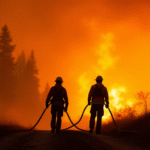Introduction
The eastern coast of the United States braced for more rain on Tuesday, following sudden flash floods that disrupted travel, left vehicles stranded, and prompted emergency rescues.
Background on the Affected Region
The northeast region of the United States, encompassing states like New York, New Jersey, and Pennsylvania, frequently experiences heavy rainfall due to its geographical location. This area is prone to sudden and severe weather events, including flash floods, which can cause significant disruptions to daily life and transportation.
Impact of the Sudden Floods
On Monday, heavy downpours led to rapid water accumulation in urban areas, catching many residents and commuters off guard. The sudden floods resulted in:
- Travel Disruptions: Numerous roadways and public transportation systems faced significant delays or closures, causing inconvenience for thousands of travelers.
- Stranded Vehicles: Many motorists found themselves trapped in their cars as roads turned into treacherous rivers, requiring emergency services to conduct numerous water rescues.
- Emergency Rescues: Local authorities reported a surge in emergency calls, with rescue teams working tirelessly to save people trapped in flooded buildings and vehicles.
Who is Affected?
The sudden floods impacted a wide range of individuals, from daily commuters to business owners and residents in affected neighborhoods. Some notable groups include:
- Commuters: Daily commuters, particularly those relying on public transportation or driving through major roadways, faced extended travel times and potential cancellations.
- Business Owners: Local businesses, especially in low-lying areas, experienced property damage and loss of inventory due to water intrusion.
- Residents: Homeowners and renters in flood-prone neighborhoods had to deal with water damage, power outages, and the stress of ensuring their families’ safety.
Why is This Relevant?
Understanding the impact of sudden floods in the northeast U.S. is crucial for several reasons:
- Public Safety: Recognizing the risks associated with flash floods helps individuals take necessary precautions and stay informed about weather updates.
- Emergency Preparedness: Local authorities and emergency services must be adequately prepared to respond swiftly and efficiently during such events.
- Infrastructure Resilience: Investing in flood-resistant infrastructure and urban planning can mitigate the long-term consequences of these weather events.
Key Questions and Answers
- Q: What caused the sudden floods?
A: Heavy rainfall, combined with urban runoff and inadequate drainage systems, led to rapid water accumulation and flash floods.
- Q: How did the floods affect travel?
A: Roadways and public transportation systems faced significant delays or closures, causing inconvenience for thousands of travelers.
- Q: Who was most affected by the floods?
A: Commuters, business owners, and residents in flood-prone neighborhoods were among those most impacted.
- Q: Why is it important to be aware of these events?
A: Understanding the risks and impacts of sudden floods helps individuals take necessary precautions, supports emergency preparedness efforts, and promotes infrastructure resilience.






